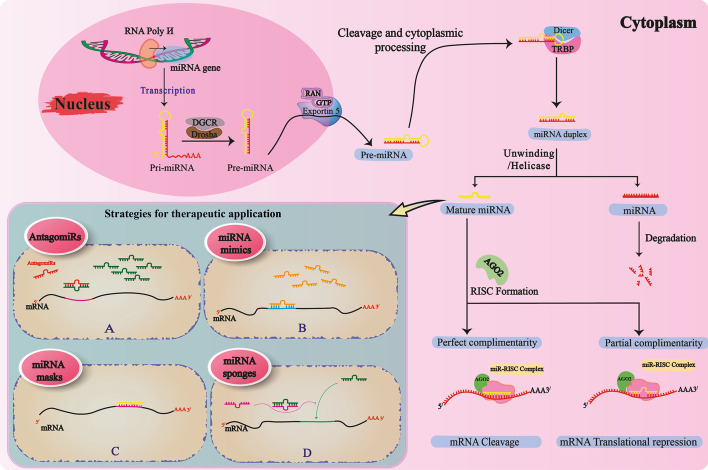Fig. 1.
Processing of miRNAs, from biogenesis to therapeutic strategies. miRNAs are transcribed from particular genes inside the nucleus through the action of RNA polymerase II. After the formation of pri-miRNA, this is developed to pre-miRNA by the Drosha–DGCR complex. Then, the pre-miRNA leaves the nucleus for the cytoplasm via exportin 5. Following particular cytoplasmic processing and the action of the Dicer–TRBP complex, pre-miRNA is converted into duplex miRNA, which then undergoes an unwinding to produce mature miRNA. Mature miRNA, using the Ago-2 protein, forms a complex with RISC to cleave the mRNA of interest, or suppresses the translation process. In the case of therapeutic strategies attributed to miRNAs, there are four distinct strategies: A AntagomiRs that bind to and inhibit the action of oncomiRs by blocking miRNA-to-mRNA attachment, through a process called antisense action. AntagomiRs are also responsible for further degradation of miRNAs; B miRNA mimics, which help anticarcinogenic miRNAs to induce tumor-suppressive activities by reversing the epigenetic silencing; C miRNA masks that prevent miRNAs from acting on mRNAs by masking the 3′-UTR sequence on the mRNA strand; D miRNA sponges, whose behavior prevents miRNAs from acting on mRNAs by occupying the binding sites of a particular miRNA or even a set of miRNAs with similar seed sequences by a complementary RNA sequence. Ago2 Argonaute RISC catalytic component 2; DGCR DiGeorge syndrome critical region; GTP guanosine triphosphate; RISC RNA-induced silencing complex; RNA poly RNA polymerase; TRBP TAR RNA binding protein

